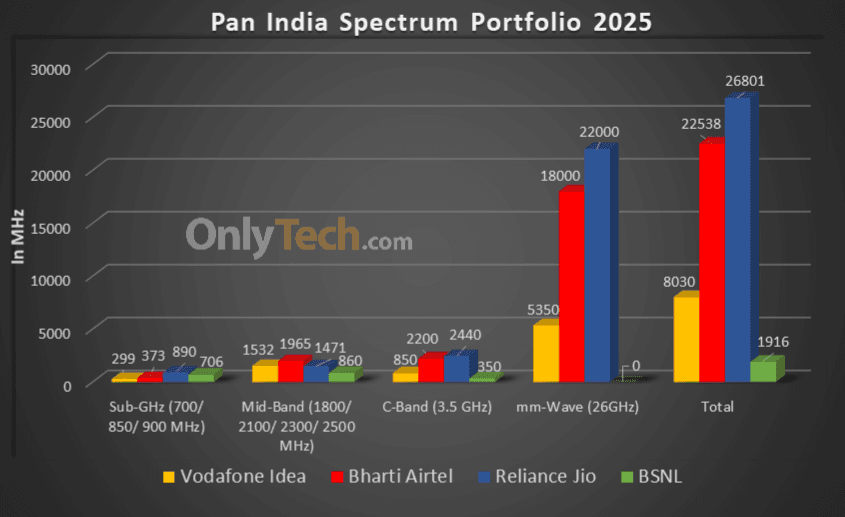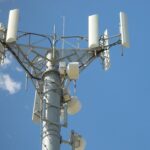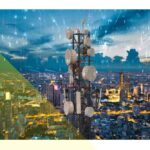Spectrum is for telecommunication what jet fuel is for aviation. Spectrum is a range of electromagnetic frequencies or airwaves that telecom companies use for establishing a connection between a cell tower and a mobile phone. The bandwidth of this spectrum is directly proportional to the speed of a wireless data network (since more data can be transmitted simultaneously through a broader data pipeline). In contrast, the frequency is inversely proportional to the coverage (since lower frequencies penetrate better through physical barriers and thus have wider coverage).
The spectrum holding data sheet embedded in this article represents the current spectrum holdings of all active telecom operators across all frequency bands across all 22 telecom circles along with their liberalisation status and expiry dates. All figures represented are in MHz. The value mentioned in the bracket beside the frequency at the base of each sheet is the band number where ‘B’ stands for 4G LTE band whereas ‘n’ stands for the corresponding 5G NR band.
The spectrum shown under BSNL and Aircel in white is reserved for the respective operators but has not yet been officially allotted to them.
Spectrum Liberalisation:
Spectrum was administratively allocated to operators in each of the 22 licensed service areas or circles prior to 2010, this spectrum is called non-liberalised and can only be used for 2G services whereas all airwaves allotted post-2010 have been through a Spectrum Auction where operators have paid the market discovered price and this spectrum is called liberalised and can be used for any technology platform 2G/3G/4G/5G. Alternatively, operators may choose to liberalise their administratively allotted spectrum by paying the market-discovered price to DoT on a pro-rata basis for the remaining validity of the spectrum.
Paired and Unpaired spectrum:
Spectrum may be paired or unpaired, bands 1/3/5/8/28 are all paired where one set of frequencies is used for uplink whereas another distinct set of frequencies is used for downlink known as Frequency-division duplexing (FDD), whereas bands 40/41/78/258 are unpaired where both uplink and downlink happens in the same set of frequencies separated by the time of uplink and downlink known as Time-division duplexing (TDD).
List of Indian FDD Bands:
| 4G LTE band | 5G NR band | Uplink frequency range (MHz) | Downlink frequency range (MHz) | Bandwidth for telecom (MHz) | Block size (MHz) |
|---|---|---|---|---|---|
| B1 | n1 | 1939-1979 | 2129-2169 | 40×2 | 5×2 |
| B3 | n3 | 1710-1780 | 1805-1875 | 70×2 | 0.2×2 |
| B5 | n5 | 824-844 | 869-889 | 20×2 | 1.25×2 |
| B8 | n8 | 890-915 | 935-960 | 25×2 | 0.2×2 |
| B28 | n28 | 723-733/ 738-748 | 778-788/ 793-803 | 20×2 | 5×2 |
List of Indian TDD Bands:
| 4G LTE band | 5G NR band | Frequency range (MHz) | Bandwidth for telecom (MHz) | Block size (MHz) |
|---|---|---|---|---|
| B40 | n40 | 2300-2380 | 80 | 10 |
| B41 | n41 | 2535-2555/ 2615-2655 | 60 | 10 |
| – | n78 | 3300-3670 | 370 | 10 |
| – | n258 | 24250-27500 | 3250 | 50 |
Spectrum caps:
A spectrum cap dictates how much spectrum a particular operator can hold in a circle for a specific band. There is a 40% cap for Sub-GHz spectrum in the 700/850/900 MHz bands combined, a 40% cap for Mid-Band spectrum in the 1800/2100/2300/2500 MHz bands combined, a 40% cap for the C-Band spectrum of 3300-3670 MHz and a 40% cap for the mm-Wave spectrum bands of 24.25-27.5 GHz. The current spectrum caps are denoted in the spectrum chart.
Overall spectrum holdings of operators (in MHz):
| Operator/Holding | Jio | Airtel | Vi | BSNL |
|---|---|---|---|---|
| Sub-GHz | 890 | 373.2 | 298.8 | 706 |
| Mid Band | 1470.8 | 1964.9 | 1531.6 | 860 |
| C-Band | 2440 | 2200 | 850 | 350 |
| mm-Wave Band | 22000 | 18000 | 5350 | 0 |
| Total | 26,800.8 | 22,538.1 | 8,030.4 | 1,916 |
Spectrum sharing/trading/leasing guidelines:
- Telecom operators holding CMTS/UASL/UL licenses can enter into a Spectrum-Sharing agreement with each other so long as both parties hold liberalised spectrum in the same band in the same circle. Spectrum sharing is possible only on a Pan LSA level in block sizes defined by DoT and only after one year of an operator acquiring the spectrum.
- Telecom operators holding CMTS/UASL/UL licenses can enter into a Spectrum-Trading agreement with each other so long as the spectrum being sold is liberalised. Trading of spectrum is possible only on a Pan LSA level in block sizes defined by DoT and only after two years of an operator acquiring the spectrum.
- Telecom operators may enter into a Spectrum-Leasing agreement only with Enterprises holding a Captive Non-Public Network (CNPN) license and not with each other. The lease may be limited to any geographic area within the LSA and for any duration mutually agreed upon by both parties. A CNPN licensee can lease spectrum from multiple operators within an LSA.
Note: We update this chart in real-time to ensure it is always up to date with the latest changes in spectrum holding. Certain human errors might have crept in during the manual compilation of the data, any mistakes/ rectification can be brought to the Team’s notice through the comments section below.








@Ankit kumar @esmail Does vi discriminate between idea users and vodafone users for speeds or quality of service ? Why do they cap speeds at 45 mbps DL and 15 Mbps UL ? Do operators discriminate between roaming users and home circle users ? If so then why ?
Only VF does that.Even when it was seperate entity it was doing this.You won,t find this with jio or airtel in roaming.Other Thing to note is that VF sims run at QCI 8 where as all others Idea,Airtel and Jio used QCI 9.That also creates discrimination when idea and VF users of same circle are connected to same site.VF users will get more priority despite both VF and Idea users pay same price.
QCI ?
Does JIO turn off its B40 in late night ? Why does it even suck at that time ? Hardly reaches 20-25 Mbps DL.
Can anyone check Jio B5 deployment for Himachal pradesh, Rajasthan, Jammu & Kashmir, North East and Assam circles ?
Himachal, Rajasthan and Jammu has been 10MHz since 2018 why are u still asking about that?
How is that possible bro when RCOM spectrum sharing with Jio is not live in J&K circle ?
RCOM spectrum sharing with Jio is currently live only in North East and Assam circles but that does not necessarily imply that they have deployed that spectrum as single contiguous block of 10 mhz in B5 (as there is possiblity of blocks being non-contiguous). Moreover currently Jio does not have any spectrum sharing pact with RCOM in J&K circle. So how can you say that Jio has 10 Mhz B5 in J&K circle ?
Spectrum sharing does not simply imply two telcos agreeing to use each other’s spectrum. They notify DoT about their intent to share and pay administrative fees and a lot other fees on top of the usual SUC and annual spectrum charges. DoT would then do everything to let the shareholders use it in anyway they want which includes rearranging the spectrum block to allow contiguous deployment. Who mentioned Jio has no sharing pact with RCom in J&K? What would RCom do with the premium B5 spectrum
As per @Esmail bro currently Jio does not have any spectrum sharing pact with RCOM in J&K circle.
You are wrong. In the case of spectrum sharing aggrements, DOT would not rearrange the spectrum blocks of operators. Similar was the case in Haryana circle before auctions as RCOM’s 5 mhz B5 block was non-contiguous with Jio’s 5 mhz B5 block. So there were 2 different B5 blocks with 2 different B5 EARFCN’s in Haryana circle for Jio B5 before auctions. After the auctions Jio made it single 10 mhz contiguous block of B5.
Yes spectrum sharing agreement does not compel the Dot to harmonise the spectrum to make it contiguous for ease of deployment for the operators. Though if they decide to go for spectrum trading instead, then dot will take into consideration all the spectrum blocks ‘owned’ by an operator and try to make them contiguous when it conducts the next round of harmonisation usually before an auction or when allocating the fresh spectrum won in an auction to the operators.
No spectrum sharing pact in UP (west) also. There also RCOM has 5 mhz B5 block. I don’t know what is RCOM doing with their B5 5mhz blocks in J&K and UP (west). Esmail bro can you answer the same ?
In general Rcom can use their own liberalised spectrum for standalone 4G services for enterprise segment. Even though they have shutdown service for general population they still offer it for enterprise users which is why they didn’t want their telecom license to expire and asked Dot to renew it. They still report subscriber figures to TRAI every month. You can even find their network in the scans in circles where they dont have 850 MHz but have 2100 MHz spectrum which they are using for the 4G service.
As for J&K yes it was never sharing the 850 MHz spectrum with Jio, the deal was signed for 21 circles leaving out J&K because back then Rcom’s 2.5 MHz which was administratively allotted in 2004 and the additional 2.5 MHz that it had won in auction were not contiguous as a 5 MHz chunk which would not have served Jio’s purpose.
now with new guideline,
Sharing of MSC core is adde alongwith tower,fiber and active antenna.
so its easy for rcom to share or use jio’s or airtel msc with /without sharing spectrum.
Rcom only want DOT should extend licenbse by migrating to UL without any pre condition of payment like AGR, spectrum due or license fee, by highlighting that its still under IBC morarorium period.
also SUC overburden is rmoved for specctrum sharing